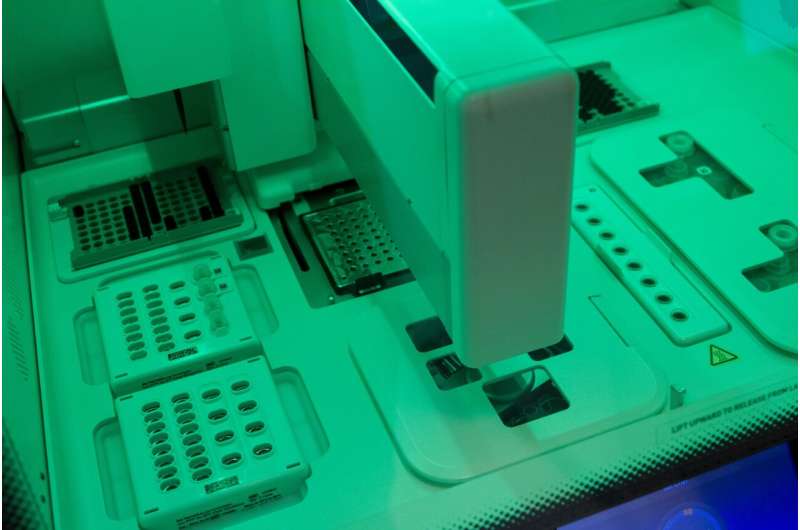This article has been reviewed according to Science X's editorial process and policies. Editors have highlighted the following attributes while ensuring the content's credibility:
fact-checked
peer-reviewed publication
proofread
New genotype tests reveal most Brits have Neanderthal DNA

A leading testing expert says DNA genotype testing is revealing how most of us have a little Neanderthal in our blood, and how our unique DNA sequence can reveal our origins and track our ancestors' migration over 50,000 years.
If you have ever felt you don't quite fit into modern society, that could be the "caveman" in you. Every one of us has inherited DNA that stretches back 50,000 years and more. Parts of that DNA may still play a part in our appearance and how we perceive the world.
New tests focusing on elements in our DNA called Ancestry Informative Markers (AIMs) can track ancestry back to the Stone Age (Paleolithic period) and map our lineage across time and locations. Indeed, the U.S. Library of Medicine reports it's possible that certain genetic variations inherited from our ancient ancestors could even play a role in everything from our height and hair texture to our sense of smell and how well we adjust to heights.
Leading testing expert, Dr. Avinash Hari Narayanan (MBChB), Clinical Lead at London Medical Laboratory, says, "Modern humans like ourselves only reached the British Isles around 40,000 years ago and, because of the impact of the last ice age, Britain was only continually settled around 12,000 years ago. Much of our DNA dates back much further than this, meaning our origins can be traced back to places far beyond Britain.
"The journey that each of our ancestors took may be very different from that of our friends' and neighbors' ancestors, however, and these different migratory paths, from thousands of years ago, are still captured and represented in our blood.
"Fascinatingly, the majority of Brits have a small amount of genetic material from humans who actually arrived here far earlier than modern man. Genetic testing reveals that people of European or Asian backgrounds have around 2% Neanderthal DNA, with some individuals having even more. People of African descent, in contrast, are likely to have far less, around 0.3%.
"Neanderthals evolved in Europe and Asia while modern humans—our species, Homo sapiens—were evolving in Africa. Modern humans migrating into Europe are now thought to have met and interbred with Neanderthals. Those of us with a percentage of Neanderthal in our DNA share some genes with Britain's earliest colonizers.
"Early humans may have arrived in Britain as long as 950,000 years ago. We know Neanderthals had arrived here 400,000 years ago thanks to the discovery of the skull of a young woman in Swanscombe, Kent. The National History Museum says these early humans probably traveled across the vast prairies of ancient Britain following herds of large animals, such as mammoths, to seasonal hunting grounds.
"It used to be thought that Neanderthals and modern humans shared no genetic makeup and that modern humans may have even killed off the Neanderthals. However, more recent research has shown that modern humans overlapped with Neanderthal populations for a period.
"A paper published in Nature in 2014 traced the complete genome sequence of a Neanderthal woman from the Altai Mountains in Siberia. It found evidence of inbreeding, possibly as small groups became isolated due to factors such as climate change. This could have hurried their extinction.
"It's not only the distant origins of mankind that can be mapped using modern genotesting. DNA testing tells us about the migration patterns of both our paternal and maternal lines, based on our genetics. Genotyping charts a migration map, tracing the maternal and paternal lineage through DNA "haplogroups" (groups that share a common ancestor).
"Some of the information contained within our Ancestry Information Markers can also link us with modern populations today. For example, London Medical Laboratory's new DNA Genotype Profile test compares our genetic profile with reference datasets of 150+ populations, based around 37 clusters in different continents and regions. The test reveals the proportion of various modern populations recorded within our own individual genetic makeup. For example, the test may indicate that our ancestry is approximately 50% African, 25% European, 20% Asian, and 5% unknown.
"Taking a test can reveal some fascinating insights into our ancestry, sometimes revealing surprises along the way. In the future, it could also have a more practical medical application. It's possible that variations in our DNA may influence the risk of developing certain diseases. As we study more about our ancestors and their genetic makeup, we may be able to build up patterns of disease risk.
"To find out what secrets your DNA holds about your ancestral lineage is surprisingly easy. London Medical Laboratory's simple saliva test can be taken at home or through the post, or at one of the many drop-in clinics that offer it across London and nationwide in over 95 selected pharmacies and health stores."




















